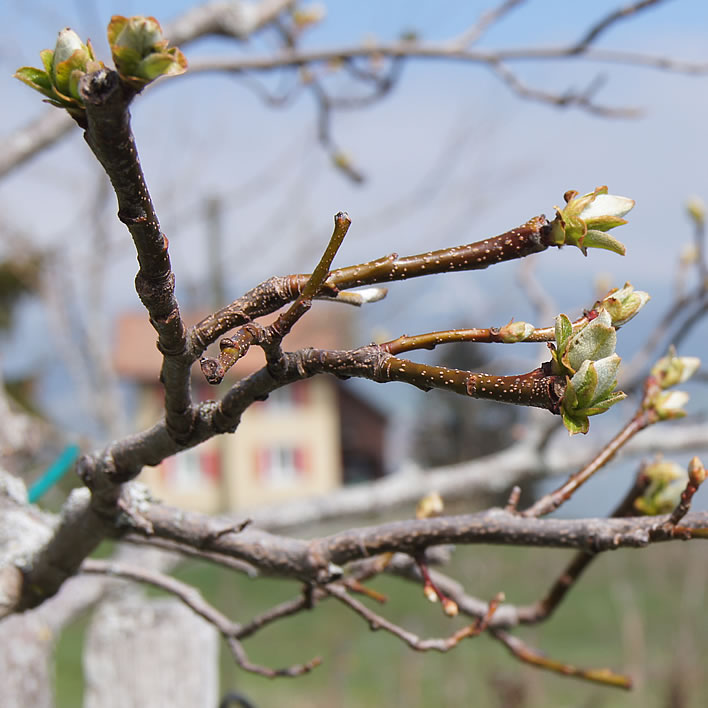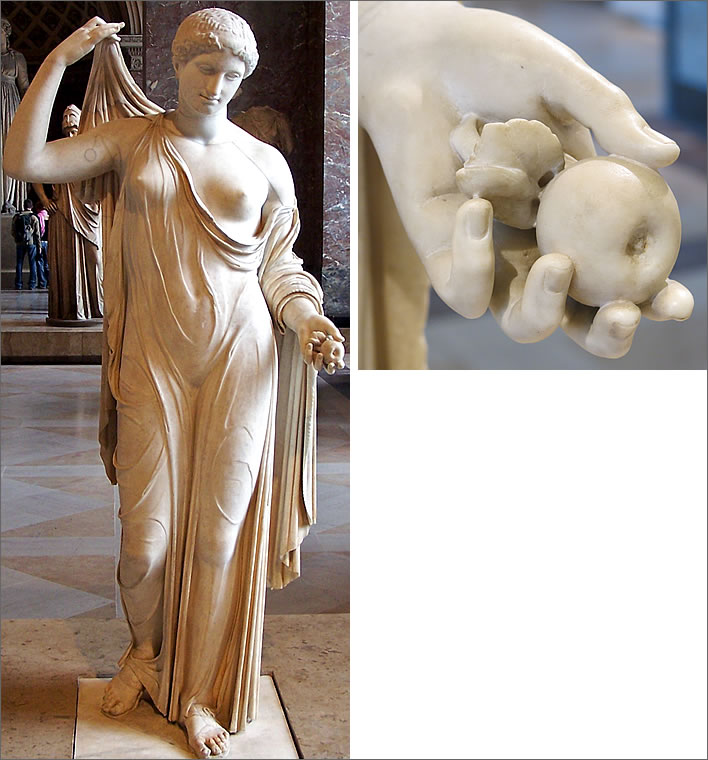The quince
Posted by Richard on UTC 2019-10-08 14:03
The quince is a mystery fruit.
The greatest mystery is that it has been cultivated for thousands of years despite all its faults: its fruit is generally very hard; it tastes bitter (not just sour – bitter); the fluff that covers unripe fruits is even more bitter than the fruit and must be carefully scrubbed away; once cut open, the flesh of the fruit oxidises very quickly to an unattractive brown; just in case that doesn't put you off, the seeds give off hydrogen cyanide in the stomach – though you would have to eat an awful lot of them in order to propel your spirit into the afterlife.
Perhaps this popularity is only a mystery for us well-fed moderns, few of whom ever make the acquaintance of the sort of hunger that will make you eat anything you come across.
Although the quince still has its adherents, for most of us the range and variety of other fruits available to us, particularly quince equivalents such as apples and pears, have caused the quince to fall out of fashion.
Getting it to the state where it can be eaten is just too much like hard work for the busy modern. The only way to make it edible is to boil it up with enough sugar (the same applies to rose-hips) to counteract the bitterness. Grandmother's quince jelly is essentially sugar that has been flavoured with the unique perfume of the quince – it has to be a jelly not a jam because then all the bitter flesh gets left behind. The quince supplies all the pectin needed for setting. The process of making the quince edible destroys what few beneficial substances were in the raw fruit; in this characteristic the quince is once again comparable to rose-hips.
Particularly in the late-autumn quince season, enterprising cooks come up with enterprising ways to eat quince, but all this enterprise and effort would not be necessary if the fruit of the quince were half-way edible in its own right.
Eastern European drunks mash it, ferment it and distill it to produce a potable spirit. But then – they do that to almost anything. There are other concoctions around which seem to be a bit like limoncello, that other source of a sugar rush.
It is, however, a very attractive fruit-tree with a particularly fine blossom and scent. Here is a photographic record of the quince through the growing season:

|
| April |

|

|

|

|

|

|
May |

|

|

|

|

|

|

|

|

|

|

|

|

|

|

|

|

|

|

|

|
June |

|

|

|
| July |

|
August |

|

|

|

|

|

|
September |

|

|

|

|

|
October |

|

|

|

|

|

|
November |

|
Click on the thumbnail to display the full-size image. All images ©Figures of Speech 2019. Reproduction only with a link to this page.
Yet another mystery is the association of the quince with Aphrodite. One bite into the fruit and the last thing you will think of is love.
Forty years ago Geoffrey Grigson (1905-1985) wrote a book, The Goddess of Love, in which he dedicated a page or two to the quince as one of Aphrodite's fruity attributes. When elderly literary chaps write about Aphrodite, a defibrillator should always be to hand:
A Greek familiar with the poem would at once have understood why Ibykos began with quinces. It is the power of scent again—the swelling fruits ripening into perfume. Yet the first links between quinces or quince trees and Aphrodite are quince buds and flowers. In early spring, the beginning of the special season of love, the five sepals of each quince flower bend back from a remarkably firm bud, which is pointed, and at first less pink than brown. The bud swells and stands erect, opening to its rose-like shape of tender pink, each petal lightly netted and veined.
Little can have seemed more delicious in gardens in Sicily or on Samos, where Ibykos wrote his poem, than a quince bush or quince tree suffused with the tint of the buds and the open flowers. The flowers, too, have their scent; not very strong, yet sweet and piercing if you smell them close enough—the scent of narcissi.
From their shape and the soft grey bloom which covers their firmness, young quinces were likened to the breasts of young girls (Leonidas of Tarentum, in the third century B.C., wrote a poem on the famous picture of Aphrodite Anadyomene by Apelles. Apelles sees her new born, still bubbling with the foam: she wrings out her hair, her eyes gleam calmly with love, and her breast 'announcing her prime, is a quince'). The quinces swell, then ripen and turn yellow and develop a perfume of exactly that sharp-scented quality of the aphrodisiac, a heavenly smell so pervasive that a few ripe quinces in a bowl will scent a room.
Geoffrey Grigson. The Goddess of Love: The birth, triumph, death and return of Aphrodite, Constable and Company Limited, London, 1976, p. 200.
Stand back! THUD! Again! THUD! It's no good… he's gone. Another good man lost to venereal disease – will we never find a cure?

The statue of Venus genetrix in the Louvre, holding an apple, not a quince. The statue is a Roman copy of a lost Greek original by the sculptor (not the poet) Callimachus, done some time in the late fifth century BC. The Louvre adds: 'In her other hand is the golden apple presented by Paris after he had judged her to be the most beautiful goddess. The apple is a modern addition, but it matches many smaller antique copies made in terracotta and bronze.' Images: left: Sebastià Giralt (2003); right: Wikimedia (2015).
Of course, in talking about the quince, we hardy Europeans, the streaks of cold rain zigzagging at this very moment down our windowpanes, are probably talking of quinces that are quite different to those grown in Classical times in places where you didn't need to wear clothes, even in October. The hard, unforgiving quince we know may just be a survival strategy in so called temperate climates.
Pliny the Elder, in The Natural History, knew of many varieties of quince and gave details of a few of them. However, Pliny tells us that only one grafted variety (which may not be a quince at all) could be eaten raw, a statement which reinforces our present prejudice that even Mediterranean and Near Eastern climates cannot do anything about the inedible bitterness of the fruit of the quince – only large dollops of sugar or honey will manage that.
As it happens, Grigson's third wife was the famous cook and food writer Jane Grigson (1928-1990, née McIntire), who was one of the 'enterprising cooks' we mentioned. She presented a large number of recipes for the quince in Jane Grigson's Fruit Book (1982). The recipes can be summarised as 'lots of exciting ways to flavour sugar'.
Grigson, before he expired in erotic hyperventilation, left us another paragraph on the 'quinces are for Venus' theme:
Everyone knew that quinces meant love, that Aphrodite in her bird-powered vehicle carried quinces as well as myrtle and roses, and that eating quinces (which needed cooking and sweetening with honey, since they were so hard and tart – bitter-sweet, like love), increased appetite in bed. According to Plutarch, in some precepts he addressed to two young friends of his who had just married, Solon the great law-giver of Athens in the sixth century B.C. (he was a poet as well) advised newly married girls to eat a quince before sharing a bed for the first time with their husbands – it would make for pleasure and harmony.
Ibid.
We now call this kind of thing a 'sugar rush', the quince best eaten with a runcible spoon just before retiring.
0 Comments UTC Loaded:
Input rules for comments: No HTML, no images. Comments can be nested to a depth of eight. Surround a long quotation with curly braces: {blockquote}. Well-formed URLs will be rendered as links automatically. Do not click on links unless you are confident that they are safe. You have been warned!